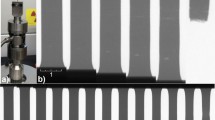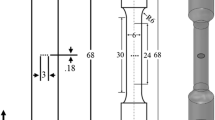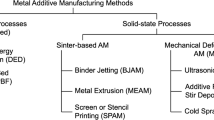Abstract
Insufficient data are available to fully understand the effects of metal additive manufacturing (AM) defects for widespread adoption of the emerging technology. Characterization of failure processes of complex internal geometries and defects in metal AM can significantly enhance this understanding. We aim to demonstrate a complete experimental measurement process and failure analysis method to study the effects of AM defects. We utilized simultaneous implementation of tensile tests with high-resolution X-ray computed tomography (XCT) measurements on 17–4 stainless steel dog-bone samples with an intentional octahedron-shaped internal cavity included in the gauge length and also containing much smaller lack-of-fusion (LOF) defects, all generated by a Laser Powder Bed Fusion (LPBF) additive manufacturing process. The LOF defects were introduced by intentionally changing the LPBF default processing parameters. XCT image-based linear elastic finite element (FE) simulations were used to interpret the data. The in-situ tensile tests combined with simultaneous XCT measurements revealed the details of the failure process initiated by additively manufactured rough internal surfaces and porous defect structures, which experienced high stress concentrations. Progressive collapse of ligaments leading to larger pores was clearly observed, and the resulting porosity evolution until failure was quantitatively analyzed. The high stress concentrations were also directly confirmed by the FE simulations. The experimental methods described in this paper enable the quantitative study of the complex failure mechanisms of additively manufactured metal parts, and the image-based FE simulation method is effective for identifying and/or confirming possible failure locations and features.

















Similar content being viewed by others
Notes
Certain commercial equipment, instruments, or materials are identified in this paper in order to specify the experimental procedure adequately. Such identification is not intended to imply recommendation or endorsement by the National Institute of Standards and Technology, nor is it intended to imply that the materials or equipment identified are necessarily the best available for the purpose.
References
Kruth JP, Leu MC, Nakagawa T (1998) Progress in additive manufacturing and rapid prototyping. CIRP Ann Manuf Technol 47:525–540. https://doi.org/10.1016/S0007-8506(07)63240-5
Murr LE et al (2012) Metal fabrication by additive manufacturing using laser and electron beam melting technologies. J Mater Sci Technol 28:1–14. https://doi.org/10.1016/S1005-0302(12)60016-4
Vandenbroucke B, Kruth JP (2007) Selective laser melting of biocompatible metals for rapid manufacturing of medical parts. Rapid Prototyp J 13:196–203. https://doi.org/10.1108/13552540710776142
McMasters MA, Benjamin MA, Mancini A, Lohmueller SJ (2014) Fuel Nozzle. USA Patent,
Ahsan MN, Bradley R, Pinkerton AJ (2011) Microcomputed tomography analysis of intralayer porosity generation in laser direct metal deposition and its causes. J Laser Appl 23:022009. https://doi.org/10.2351/1.3582311
Kim FH, Moylan SP (2018) Literature review of metal additive manufacturing defects. NIST Advanced Manufacturing Series (NIST AMS) 100-16. https://doi.org/10.6028/NIST.AMS.100-16
Kobryn PA, Moore EH, Semiatin SL (2000) The effect of laser power and traverse speed on microstructure, porosity, and build height in laser-deposited Ti-6Al-4V. Scr Mater 43:299–305. https://doi.org/10.1016/S1359-6462(00)00408-5
Ng GKL, Jarfors AEW, Bi G, Zheng HY (2009) Porosity formation and gas bubble retention in laser metal deposition. Appl Phys A 97:641–649. https://doi.org/10.1007/s00339-009-5266-3
Mancisidor AM, Garciandia F, Sebastian MS, Álvarez P, Díaz J, Unanue I (2016) Reduction of the Residual Porosity in Parts Manufactured by Selective Laser Melting Using Skywriting and High Focus Offset Strategies. Phys Procedia 83:864–873. https://doi.org/10.1016/j.phpro.2016.08.090
Thijs L, Kempen K, Kruth J-P, Van Humbeeck J (2013) Fine-structured aluminium products with controllable texture by selective laser melting of pre-alloyed AlSi10Mg powder. Acta Mater 61:1809–1819. https://doi.org/10.1016/j.actamat.2012.11.052
Yadollahi A, Shamsaei N (2017) Additive manufacturing of fatigue resistant materials: challenges and opportunities. Int J Fatigue 98:14–31. https://doi.org/10.1016/j.ijfatigue.2017.01.001
Kim FH, Villarraga-Gómez H, Moylan SP (2016c) Inspection of Embedded Internal Features in Additively Manufactured Metal Parts Using Metrological X-ray Computed Tomography. Paper presented at the ASPE/euspen 2016 summer topical meeting dimensional accuracy and surface finish in additive manufacturing, Raleigh, NC
Hrabe N, Barbosa N, Daniewicz S, Shamsaei N (2016) Findings from the NIST/ASTM workshop on mechanical behavior of additive manufacturing components. NIST Advanced Manufacturing Series (NIST AMS) 100–4. https://doi.org/10.6028/NIST.AMS.100-4
Todorov E, Spencer R, Gleeson S, Jamshidinia M, Kelly SM (2014) AMERICA MAKES: NATIONAL ADDITIVE MANUFACTURING INNOVATION INSTITUTE (NAMII) project 1: nondestructive evaluation (NDE) of complex metallic additive manufactured (AM) structures. AIR FORCE RESEARCH LABORATORY, WRIGHT-PATTERSON AIR FORCE BASE, OH 45433–7750
Kim FH, Moylan SP, Garboczi EJ, Slotwinski JA (2017) Investigation of pore structure in cobalt chrome additively manufactured parts using X-ray computed tomography and three-dimensional image analysis Addit Manuf 17:23–38 doi:https://doi.org/10.1016/j.addma.2017.06.011
Kim FH, Pintar AL, Moylan SP, Garboczi EJ (2019b) The influence of X-Ray computed tomography acquisition parameters on image quality and probability of detection of additive manufacturing defects. J Manuf Sci Eng 141. https://doi.org/10.1115/1.4044515
Buffiere J-Y, Maire E, Adrien J, Masse J-P, EJEM B (2010) In situ experiments with X ray tomography: an attractive tool for experimental mechanics. 50:289–305. https://doi.org/10.1007/s11340-010-9333-7
Alshibli K, Sture S, Costes N, Frank M, Lankton M, Batiste S, Swanson R (2000) Assessment of localized deformations in sand using X-ray computed tomography. Geotech Test J 23:274–299. https://doi.org/10.1520/GTJ11051J
Desrues J, Chambon R, Mokni M, Mazerolle F (1996) Void ratio evolution inside shear bands in triaxial sand specimens studied by computed tomography. Géotechnique 46:529–546. https://doi.org/10.1680/geot.1996.46.3.529
Kim FH, Penumadu D, Gregor J, Kardjilov N, Manke I (2013) High-resolution neutron and X-ray imaging of granular materials. J Geotech Geoenviron 139:715–723. https://doi.org/10.1061/(ASCE)GT.1943-5606.0000809
Kim FH, Penumadu D, Gregor J, Marsh M, Kardjilov N, Manke I (2015) Characterizing partially saturated compacted-sand specimen using 3D image registration of high-resolution neutron and X-ray tomography. J Comput Civ Eng 29:04014096. https://doi.org/10.1061/(ASCE)CP.1943-5487.0000424
Kim FH, Penumadu D, Kardjilov N, Manke I (2016a) High-resolution X-ray and neutron computed tomography of partially saturated granular materials subjected to projectile penetration. Int J Impact Eng 89:72–82. https://doi.org/10.1016/j.ijimpeng.2015.11.008
Turner AK, Kim FH, Penumadu D, Herbold EB (2016) Meso-scale framework for modeling granular material using computed tomography. Comput Geotech 76:140–146. https://doi.org/10.1016/j.compgeo.2016.02.019
Babout L, Maire E, Buffière JY, Fougères R (2001) Characterization by X-ray computed tomography of decohesion, porosity growth and coalescence in model metal matrix composites. Acta Mater 49:2055–2063. https://doi.org/10.1016/S1359-6454(01)00104-5
Brault R, Germaneau A, Dupré JC, Doumalin P, Mistou S, MJEM F (2013) In-situ analysis of laminated composite materials by X-ray micro-computed tomography and digital volume correlation. 53:1143–1151. https://doi.org/10.1007/s11340-013-9730-9
Moffat AJ, Wright P, Buffière JY, Sinclair I, Spearing SM (2008) Micromechanisms of damage in 0° splits in a [90/0]s composite material using synchrotron radiation computed tomography. Scr Mater 59:1043–1046. https://doi.org/10.1016/j.scriptamat.2008.07.034
Penumadu D, Kim F, Bunn J (2016) Damage of composite materials subjected to projectile penetration using high resolution X-ray micro computed tomography. Exp Mech 56:607–616. https://doi.org/10.1007/s11340-015-0085-2
Maire E, Zhou S, Adrien J, Dimichiel M (2011) Damage quantification in aluminium alloys using in situ tensile tests in X-ray tomography. Eng Fract Mech 78:2679–2690. https://doi.org/10.1016/j.engfracmech.2011.07.004
Sham TK, Rivers ML (2002) A brief overview of synchrotron radiation. Rev Mineral Geochem 49:117–147. https://doi.org/10.2138/gsrmg.49.1.11
Burnett TL, McDonald SA, Gholinia A, Geurts R, Janus M, Slater T, Haigh SJ, Ornek C, Almuaili F, Engelberg DL, Thompson GE, Withers PJ (2014) Correlative tomography. Sci Rep 4:4711. https://doi.org/10.1038/srep04711
Maire E, Withers PJ (2014) Quantitative X-ray tomography. Int Mater Rev 59:1–43. https://doi.org/10.1179/1743280413Y.0000000023
Kim FH, Penumadu D, Patel P, Xiao X, Garboczi EJ, Moylan SP, Donmez MA (2016b) Synchrotron 4-dimensional imaging of two-phase flow through porous media. MRS Adv 1:2757–2761. https://doi.org/10.1557/adv.2016.505
Murakami Y, Beretta S (1999) Small defects and Inhomogeneities in fatigue strength: experiments, models and statistical implications. 2:123–147. https://doi.org/10.1023/a:1009976418553
Beretta S, Romano S (2017) A comparison of fatigue strength sensitivity to defects for materials manufactured by AM or traditional processes. Int J Fatigue 94:178–191. https://doi.org/10.1016/j.ijfatigue.2016.06.020
Edwards P, Ramulu M (2014) Fatigue performance evaluation of selective laser melted Ti–6Al–4V. Mater Sci Eng A 598:327–337. https://doi.org/10.1016/j.msea.2014.01.041
ASTM E8/E8M (2016) Standard test methods for tension testing of metallic materials. ASTM International
Kim FH, Moylan SP, Garboczi EJ (2019a) Preparation of cylindrical tensile specimens for simultaneous mechanical testing and X-ray computed tomography. NIST Interagency/Internal Report (NIST IR):8234. https://doi.org/10.6028/NIST.IR.8234
EOS GmbH - Electro Optical Systems (2009) EOS StainlessSteel GP1 for EOSINT M 270
Slotwinski JA, Garboczi EJ, Stutzman PE, Ferraris CF, Watson SS, Peltz MA (2014) Characterization of metal powders used for additive manufacturing. J Res Natl Inst Stand Technol 119:460–493. https://doi.org/10.6028/jres.119.018
Cheruvathur S, Lass EA, Campbell CE (2016) Additive manufacturing of 17-4 PH stainless steel: post-processing heat treatment to achieve uniform reproducible microstructure. JOM 68:930–942. https://doi.org/10.1007/s11837-015-1754-4
Jacob G (2018) Prediction of solidification phases in Cr-Ni stainless steel alloys manufactured by laser based powder bed fusion process. NIST Advanced Manufacturing Series (NIST AMS) 100-14. https://doi.org/10.6028/NIST.AMS.100-14
Luecke WE, Slotwinski JA (2014) Mechanical properties of austenitic stainless steel made by additive manufacturing. J Res Natl Inst Stand Technol 119:398–418. https://doi.org/10.6028/jres.119.015
Bonse U, Busch F (1996) X-ray computed microtomography (μCT) using synchrotron radiation (SR). Prog Biophys Mol Biol 65:133–169. https://doi.org/10.1016/S0079-6107(96)00011-9
Kardjilov N, Dawson M, Hilger A, Manke I, Strobl M, Penumadu D, Kim FH, Garcia-Moreno F, Banhart J (2011) A highly adaptive detector system for high resolution neutron imaging. Nucl Instrum Meth A 651:95–99. https://doi.org/10.1016/j.nima.2011.02.084
ASTM E1441 (2011) Standard guide for computed tomography (CT) Imaging
ASTM E1695 (2013) Standard test method for measurement of computed tomography (CT) system performance
Buzug TM (2008) Computed tomography from photon statistics to modern cone-beam CT. Springer-Verlag, Berlin
Tobin KW, Bingham PR, Gregor J (2009) Mathematics of neutron imaging. In: Bilheux HZ, McGreevy R, Anderson IS (eds) Neutron imaging and applications: a reference for the imaging community. Springer US, Boston, pp 109–127. https://doi.org/10.1007/978-0-387-78693-3_7
Nyquist H (1928) Certain Topics in Telegraph Transmission Theory. Trans Am Inst Electr Eng 47:617–644. https://doi.org/10.1109/T-AIEE.1928.5055024
Feldkamp LA, Davis LC, Kress JW (1984) Practical cone-beam algorithm. J Opt Soc Am A 1:612–619. https://doi.org/10.1364/JOSAA.1.000612
Kak AC, Slaney M (2001) Principles of computerized tomographic imaging. Society of Industrial and Applied Mathematics, New York
Buades A, Coll B, Morel J-M (2011) Non-local means Denoising image processing on line. 1:208–212. https://doi.org/10.5201/ipol.2011.bcm_nlm
Volume Graphics (2018) VG Studio Max 3.1. https://www.volumegraphics.com/
Bernsen J (1986) Dynamic thresholding of grey-level images. Paper presented at the international conference on pattern recognition, Paris, France
Phan TQ, Kim FH, Pagan DC (2018) Micromechanical response quantification using high-energy X-rays during phase transformations in additively manufactured 17-4 stainless steel, under review. Mater Sci Eng A
Garion C (2014) Mechanical properties for reliability analysis of structures in glassy carbon. World J Mech 4:79–89. https://doi.org/10.4236/wjm.2014.43009
Bohn RB, Garboczi EJ (2003) User manual for finite element and finite difference programs: a parallel version of NISTIR 6269 and NISTIR 6997. NIST Interagency/Internal Report (NISTIR) 6997
Garboczi EJ (1998) Finite element and finite difference programs for computing the linear electric and elastic properties of digital images of random materials. NIST Interagency/Internal Report (NISTIR) 6269
Henry BS, Luxmoore AR (1997) The stress triaxiality constraint and the Q-value as a ductile fracture parameter. Eng Fract Mech 57:375–390. https://doi.org/10.1016/S0013-7944(97)00031-3
Gurson AL (1977) Continuum Theory of Ductile Rupture by Void Nucleation and Growth: Part I—Yield Criteria and Flow Rules for Porous Ductile Media. J Eng Mater Technol 99:2–15. https://doi.org/10.1115/1.3443401
Needleman A, Tvergaard V (1984) An analysis of ductile rupture in notched bars. J Mech Phys Solids 32:461–490. https://doi.org/10.1016/0022-5096(84)90031-0
Acknowledgements
The authors would like to thank REX Heat Treat company for performing the heat treatment. We would also like to thank Dr. Jarred Heigel (Third Wave Systems), Mr. Mike McGlaughlin (NIST), and Mr. Jared Tarr (NIST) for assistance with the AM process and subsequent post-machining process. The authors would also like to thank Dr. Andrew Holmgren of Ball Aerospace, and Mr. Dash Weeks of NIST for assistance with preparation and carrying out the experiments. The authors would also like to thank Dr. Mark Stoudt and Dr. Lyle Levine of NIST for a useful discussion of the results. The authors thank Dr. Darren Pagan of the Cornell High Energy Synchrotron Source (CHESS) for fruitful discussion of the triaxiality factor.
Author information
Authors and Affiliations
Contributions
Contribution of the National Institute of Standards and Technology, not subject to copyright in the USA.
Corresponding author
Ethics declarations
Ethics Declarations
This article does not contain any studies involving animals performed by any of the authors. This article does not contain any studies involving human participants performed by any of the authors.
Conflict of Interest
The authors declare that they have no conflicts of interest.
Additional information
Publisher’s Note
Springer Nature remains neutral with regard to jurisdictional claims in published maps and institutional affiliations.
Rights and permissions
About this article
Cite this article
Kim, F.H., Moylan, S.P., Phan, T.Q. et al. Investigation of the Effect of Artificial Internal Defects on the Tensile Behavior of Laser Powder Bed Fusion 17–4 Stainless Steel Samples: Simultaneous Tensile Testing and X-Ray Computed Tomography. Exp Mech 60, 987–1004 (2020). https://doi.org/10.1007/s11340-020-00604-6
Received:
Accepted:
Published:
Issue Date:
DOI: https://doi.org/10.1007/s11340-020-00604-6




